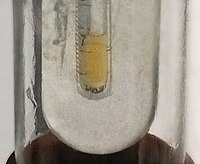
Photo from wikipedia
Abstract Undoubtedly, cyclooctane has been investigated theoretically and experimentally, however, considering the vast application of cycloalkanes and limited research for the higher members, the reactivity and structural investigation of cyclooctane,… Click to show full abstract
Abstract Undoubtedly, cyclooctane has been investigated theoretically and experimentally, however, considering the vast application of cycloalkanes and limited research for the higher members, the reactivity and structural investigation of cyclooctane, fluorocyclooctane, bromocyclooctane, chlorocyclooctane, azocane, oxocane and thiocane have been explored using density functional theory (DFT) method. In this work, we reported elaborately on some molecular and electronic properties. Interestingly, the condensed dual descriptors ( Δ f ); Br24 of bromocyclooctane compound and N22 of azocane compound has the highest positive values of 0.3561eV and 0.1618eV respectively and hence, potential sites for nucleophilic reaction compared to chlorocyclooctane, fluorocyclooctane, oxocane, thiocane and the parent cyclooctane. In the UV-VIS spectroscopic analysis, σ-π* nor π to π* transitions where observed for all the studied molecules and these molecules are expected to be colorless due to the absence of an absorption band in the visible region (380–760 nm). In all the substituted cyclooctane molecules investigated, C–F bond of fluorocyclooctane is more polar than C–O, C–S, C–N, C–Cl, C–Br bonds of other compounds. The interactions between the lone pair (LP (1) N22) and antibonding; σ*(1)C4–C5 of azocane gave the highest stabilization energy (10.44 kcal/mol) compared to other compounds investigated. We believe our detail reported work on this eight-membered ring compound and its derivatives will widen the scope of these molecules to other researchers.
Journal Title: Materials Chemistry and Physics
Year Published: 2022
Link to full text (if available)
Share on Social Media: Sign Up to like & get
recommendations!